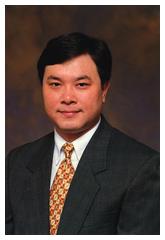A calculating fire man
Our model presents fire engineers with an accurate means of determining and evaluating safety levels in buildings by simulating an actual fire. The calculations provide information that makes more efficient use of space and building material, and help create a more cost-effective design to solve fire-related problems.
Using a unique computational technique that simulates fire, a team at City University under the leadership of Dr Richard Yuen, Associate Professor in the Department of Building and Construction, is providing fire engineers with information that will give buildings better protection against fire.
The technique, known as the three-dimensional field model for enclosed fire growth, or Fire3D, predicts the flame spread and fire development from one or more fire sources. This model simulates the development of the fire from ignition through to combustion and the subsequent release of heat and gases up to what is known in the trade as the flashover point-the point at which every combustible item in the target area is glowing.
Determining safety levels
"Our model presents fire engineers with an accurate means of determining and evaluating safety levels in buildings by simulating an actual fire," explained Dr Yuen. "The calculations provide information that makes more efficient use of space and building material, and help create a more cost-effective design to solve fire-related problems."
Dr Yuen's initial work in fire simulation involved wood pyrolysis: he simulated a fire caused by a gas burner next to a timber wall in an enclosed area. The Fire3D model predicts several significant factors: the distribution of temperature at different points in the room, turbulence, combustion of flammable items, radiation, soot sub-models, evaporation of moisture and the pyrolysis of the cellulosic fuel. Calculations are verified by replicating the fire in a controlled experiment.
"CFDs are useful calculations to use in this in which fire is considered as a chemical reaction that releases heat and produces flowing gases. There are two ways to study this phenomenon: we can burn things and investigate the consequences in experiments, or we can simulate the process using numerical calculations such as CFDs."
Dr Yuen has expanded the Fire3D model to encompass different geometries. He can now analyse pyrolysis in more complicated spaces involving multiple fire sources and different kinds of wood. In fact, the number crunching process involved in simulating wood pyrolysis is so complex that even a high-speed UNIX-based workstation such as Digital Alpha requires days and sometimes weeks to produce the necessary data.
Future applications of Fire3D
However, since the object of fire safety is to avert the initial ignition stage, Dr Yuen said future applications of the Fire3D model would investigate the reaction of materials, especially non-combustible materials, to fire rather than simply the act of combustion.
"We are moving into structural areas and looking at passive materials that do not burn. For example, we look at reinforced concrete and examine its response to heat. Although concrete doesn't burn, it loses strength in intense fire and as a result sections of concrete can fall off. This is known as spalling and, of course, it significantly weakens a structure."
In addition, the team will use the Fire3D model to investigate the effects of fire on steel, a material frequently used in tall buildings. Steel also loses significant amounts of strength in high temperatures, and although researchers have conducted limited experiments into buckling and collapse of steel structures in fires, the City University-based team will be conducting the first full-scale analysis using numerical calculations into the effects of fire on large-scale steel structures.
The CFD calculations devised by Dr Yuen are not limited to predicting the behaviour of gases in building safety. Another useful application is to facilitate designing buildings that use energy more efficiently. For example, building engineers from local industries use CFD calculations to optimize the installation points of air-conditioners. They simulate heat dissipation from the air-conditioners using the Fire3D model and thereby identify locations with problematic heat discharges.
Another application is in the design of large atriums or sports complexes where games such as badminton can be affected by biased airflow from air vents. Uneven or irregular airflow affects the trajectory of lightweight shuttlecocks, a disruption that can affect the outcome of a match.
But, since building safety remains a priority in the Building and Construction Department at City University, the Fire3D model remains at the cornerstone of fire prevention techniques.
